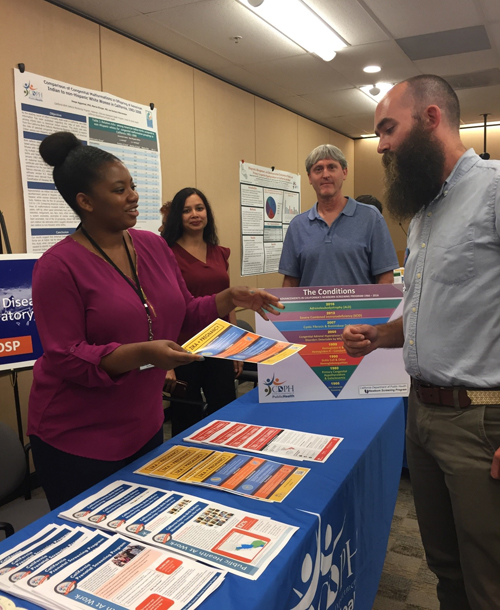Features from the Front Line: California
Spotlight on California Birth Defects Monitoring Program

During a California Department of Public Health event, staff from the California Birth Defects Monitoring Program promote Zika awareness.
State Surveillance Expands from 10 to 19 Counties in 2016
In California, the country’s most populous state, one in 33 babies, or about 14,500 babies born in 2016, had one or more birth defects. Serious birth defects are the leading cause of death for babies in California and the United States. Over a lifetime, medical care and special education for a child with birth defects can cost more than $500,000.
The California Birth Defects Monitoring Program (CBDMP) has collected population-based birth defects data in California since 1983. At the beginning of 2016, CBDMP monitored birth defects in 10 California counties. With funding from the Centers for Disease Control and Prevention (CDC) for Zika Birth Defects Surveillance (ZBDS), the state recently expanded coverage to include nine additional counties. These additional counties include those most affected by Zika virus infection (Zika) acquired through travel and with risk of local transmission, namely border and high-population counties with Aedes mosquitos. The expansion began in mid-2016 when the state added 110 medical facilities to the 92 already being monitored. Today, the program covers approximately 82 percent of California’s annual births and fetal deaths.
California Increases Support for Zika-related Birth Defects Surveillance
Along with expanded surveillance, CBDMP added two statewide Zika Pregnancy Registry (ZPR) coordinators to bridge the information exchange among state infectious disease and birth defects monitoring programs, health care providers and the local health departments. This increased support enabled continuity with USZPR hospital neonatal assessment data collection, completed by CBDMP abstractors, and faster and more complete monitoring of birth defects. In addition, by having more routine reporting of Zika-positive pregnant women, the Department of Public Health can more quickly access the data and clarify the clinical needs of the mother and child.
Custom Laptop-based Data Application
CBDMP relies on a custom laptop application that synchronizes data collection and data linkage. The application allows CBDMP staff to identify potential birth defect cases, review medical records at the hospital site without a network or Internet connection, and synchronize their data with the central database daily. CBDMP then reports data to CDC’s US Zika Pregnancy Registry and ZBDS databases, which helps guide testing, clinical evaluations, and management of public health actions related to Zika.
Data Quality Earns Highest Level of Performance
CBDMP recently completed a data quality assessment conducted in accordance with the National Birth Defects Prevention Network (NBDPN) Standards for Birth Defects Surveillance. The assessment showed that CBDMP performs at Level 3, the best level of performance. When Zika-associated birth defects were first reported, CBDMP’s infrastructure and CDC Zika funding enabled it to rapidly respond to birth defects surveillance needs across the state.
Stronger Links with Newborn Hearing Screening Programs
CBDMP is looking at better ways to learn from cases of babies born without apparent structural defects, as some babies may be born without visible Zika-related birth defects but experience issues later, such as hearing loss.
This type of follow-up monitoring and testing requires controlled data sharing with state and local newborn hearing screening programs, and meetings with these collaborators have already started. CBDMP can serve as a model and resource for other state birth defects surveillance programs preparing for Zika.
Attribute: California Department of Public Health